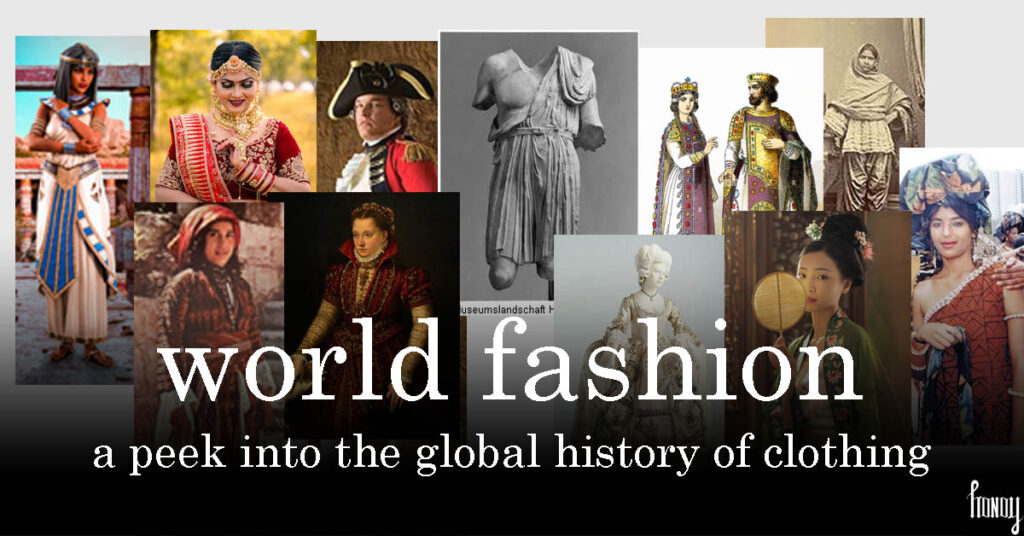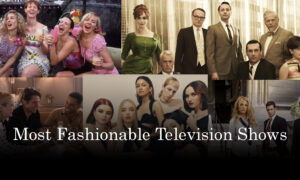Introduction
The first documented moment in fashion was when Adam and Eve wore leaves and the rest, as they say, is history! The history of world fashion is the history of mankind itself as it reflects every aspect of the time man lives in. Ever since man has discovered the joy of clothing, he has been unstoppable. The need to look good, stand apart, fulfill needs have all come together to give us a complex tapestry of fashion trajectories.
Every part of the world has its own story to tell, which unravels a unique journey of how clothing has been affected by the regional and cultural circumstances. In this post, I will inform you on a very general idea of where it all began and from there, we will start a journey of understanding the history of world fashion how over centuries our way of clothing has evolved.
The Ancient Civilizations
Egypt (c. 3000 BC – 30 BC)
The ancient civilizations of Egyptians were very advanced with their yarn making and weaving techniques. They adorned themselves in the finest linen garments and had elaborate jewelry for every part of the body. Pharaohs wore distinctive headdresses like the Nemes crown, and the iconic Egyptian sandals has influenced the modern fashion world of footwear design.
China (c. 1600 BC – 220 AD)
Just like the Egyptians, the Chinese were also very ahead of their times. They gave the world the finest fabric known to mankind. ‘Silk’, one of the most luxurious fabrics in history of fashion. The Hanfu, a traditional Chinese clothing, featured flowing sleeves and hemlines and has intricate embroidery and unique folding techniques. Even today it is a celebrated piece of national pride for every Chinese.
The Classical Influences on world fashion
Greece (c. 9th Century BC – 4th Century AD)
Ancient Greece’s clothing gave the world beautiful, draped togas. The Greeks used borders to create drapery interest and used ornamental belts, clamps, or pins to secure their garments. The Grecian chiton – a form of an off-shoulder tunic, fastened at the waist became iconic, with an emphasis on body proportions and aesthetics. Even today designers like Valentino and Elle Saab have been inspired by these timeless silhouettes.
Rome (c. 753 BC – 476 AD)
The ancient civilizations of Romans borrowed fashion from the Greeks and were heavily influenced by the Etruscans, but they added their own flair to it. They together wit the Grecian style of clothing, offered the world, the earliest know unisexual clothing. The toga, tunica, cloaks, mantels and stola were all typical garments, reflecting the Roman love for luxury and excess.
Medieval Majesty (5th – 15th Century)
Byzantine Empire
The Byzantinists were superb weavers and embroiderers. They had the finest textiles ornamented with gold thread embroideries, which was an expensive but difficult process. They held the monopoly for silk fabrics in Europe for the longest time. Their men wore elaborate tunics with trousers under the ‘dalmatica’ and the women wore intricate undergarments beneath their stola and ‘paludamentum’. Because the Byzantine had a rich trade history with the Middle East and Orient, there are influences of Asian culture that can be seen in the Byzantine history of fashion.
Islamic Fashion
The Islamic outlook on clothing emphasized modesty and practicality for the world fashion. Garments that did not reveal the body silhouette and extremities, like the abaya and kaftan were prominent. Linen. Cotton and wool were the preferred fabrics and leather was used for shoes and sandals. He Islamic dress code stood as a symbol for purity, mark statue, formal roles, distinguish believer and identify gender. Head and face covering components like the hijab and the niqab are still very much respected and worn.
Renaissance and Beyond (14th – 17th Century)
Italy
The Renaissance, a major period in the world history of art and cultural growth. The renaissance fashion gave birth to the notion of ‘bigger is better’. Clothing predominantly served as an indicator of one’s social and economic status. This was a period of elaborate gowns, shirts with huge collars, code pieces, gown sleeves and headdresses. The doublet and farthingale were the epitome of fashion.
Japan
Like the rest of the Orient, Japanese had there long-standing cultural evolution of fashion. Originally, kimono was a Japanese word for clothing, but today it stands as a symbol of longevity and good fortune. It is a form of a beautiful dress, which was from the Heian period with a skirt called Hakama. Along with this, the Japanese innovation in textiles and colors has been their contribution to the history of world fashion.
Colonial Influences on world fashion(16th – 18th Century)
India
Since the ancient times, the people of the Indus Valley civilization has been experts at sewing and embroidery, but they preferred draped garments because it extended comfort and flexibility in their lifestyles. The sari is a globally identifiable garment which has been a constant fixture of the Indian history if fashion. With every invasion, the Indian clothing story enriched as it imbued elements of every culture.
For example, the Mughal Empire influenced Indian fashion with fabrics like brocade and the introduction of the Anarkali suit. The colonial rules of French and British colonizers gave India a distinct love for jackets and safaris. The Nehru jacket is a classic example of this legacy. The legacy can be seen in Indian fashion designers work like Rohit Bal and Ritu Kumar.
Americas
Just like everywhere in the world fashion, the Indigenous peoples of America had their own unique clothing. The Anuks and moccasins are still worn today and influence the world over. The American fringed garments and traditional Mexican garments do not follow the same conventions as rest of the Europe but have their own language of fashion. Boxy garment made by joining rectangular pieces of elaborate cloths.
Victorian Elegance and history of fashion (19th Century)
England
Queen Victoria’s reign saw a proliferation of lavish silk and satin gowns with full skirts, corsets, and bonnets. The order of the day required multiple changes through out the day based on one’s financial status and the wardrobe increasingly became high maintenance. The men’s suit was the preferred choice for gentlemen. The crinoline became an iconic silhouette.
Globalization and the 20th Century
Japan
The ancient Japanese Kimonos have today evolved into modern styles. The Japanese street style is a fashion code unto itself that has major effect on fashion history, and the manga influences can be seen all over the world. Japanese designers like Yohji Yamamoto and Rei Kawakubo have revolutionized global fashion by combining Japanese way of thinking and modern aesthetics.
Africa
With globalisation and people exploring more regional fashion, the African fashion has gained recognition with its distinctive vibrant and bold prints and textiles. Icons like Miriam Makeba and Nelson Mandela influenced African style. Every designer at some point on time gets influenced by the unadulterated beauty of the African culture.
The Middle East
The Middle East became a fashion hub with designers like Elie Saab and Zuhair Murad. Giving the word opulence a whole, new meaning, these designers have brought the fine art of dress making to a level of perfection. Their evening gowns are worn by celebrities world over.
The Contemporary Era (21st Century)
Global Fusion
The 21st century is marked by a fusion of global styles, with designers and consumers embracing diversity and inclusivity. All the big brands pay homage to different cultures of the world there by influencing every stratum of the fashion cycle and bringing intercultural fashion exchange to the forefront. The internet has made it easy for everyone to access the latest fashion trends from all over the world thus giving the consumer more choices than ever before. Celebrity fashion and events like the Met gala and music festivals like Coachella are now serving as platforms for fashion influencers and trend setting. The world fashion has become more connected than ever.
Sustainable World Fashion
With the world facing the reality of global pollution and the fact that the global fashion industry is the second most polluting behind petroleum, the fashion industry has seen a shift towards sustainability. With eco-friendly materials and ethical practices gaining momentum, both the conscience consumer and designer are pushing for products that put a less burden on the earth. Natural fibers and supporting the to local artisans and culture of clothing is considered fashionable. A new history of fashion is being written with sustainable fashion.
Conclusion
As we have seen, the world fashion is an ever-weaving tapestry that is so intricately interwoven with the threads of history, culture, and innovation. Although this post covers some of the major points, it is not the complete history, nor it can ever be as it is such an expansive subject. Volumes have been documented and written on the history of fashion and volumes will keep on being written. And this is the testament to the creativity and diversity of human cultural evolution.
From ancient civilizations to the modern globalized world, fashion has played a pivotal role in shaping societies and individual identities. It is a reflecting our values and the time we live in. As we move forward, the history of fashion continues to be written, and its story remains a vital part of our shared human heritage. If there is any aspect in this post that you feel I have forgotten (which I am sure), please let me know, and stay with me as together we continue to unravel the past, the present and the future of fashion.






























Pingback: A rich history of European fashion – part 1 - Fashionology
Pingback: The unique Leather Puppetry of Andhra Pradesh in 5 min
Pingback: tThe rich history of Idu Mishmi 5 mins
Pingback: The exotic golden Muga silk of Assam in 5 mins
Pingback: The heart of Bihari craft Khatwa patchwork in 5 mins
Pingback: Jewel of Andhra Allagadda Stone Carving 5 mins
Pingback: 10 best fashion museums in France
Pingback: 10 Best books to read on fashion
Pingback: 10 Most thrilling books to read on fashion
Pingback: The Best Way To Research For A Fashion Collection In 9 Steps